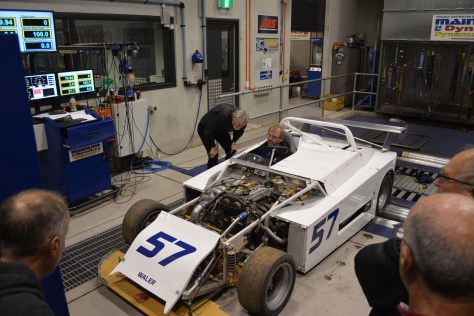
It has been a number of years since the Sprite Club has held a Technical Night, so approx. 30 members headed on Friday 29thMarch to the TAFESA Automotive Campus at Regency Park. Club President and TAFE Principal Lecturer Gordon Boyce and fellow Automotive Jamie Campbell had arranged a night that covered a number of specific technical topics that related to Sprites,Midgets and Clubmans.
After an overview of the TAFE Campus and the Automotive Program by Gordon, Jamie discussed the main issues with making power with any internal combustion engine, this particularly is the amount of air that can enter the engine, once mixed with fuel and ignited will produce power and torque. Jamie has spent many hours testing both air flow of various components (carbies, manifolds, air filters and cylinder heads) and how these affect the performance of the engine. The TAFE facilities have both engine and chassis dynamometers, for motorcycles, cars and trucks as well as a flow bench for testing individual components.
Jamie had been provided with a number of A-Series engine components (cylinder head, manifolds and carburettors) and these were tested on the Flow Bench. This device, a “high-tech vacuum cleaner” can measure the flow of air through a component in cubic feet per minute (CFM). Jamie started with a standard Bugeye cylinder head and measured an air flow of approx. 63 CFM for the inlet port. Jamie noted that this was one of the worst performing head he had bench tested, but understood that a design of over 60 years old would have been comparable with similar vehicles of the era.
Next was a twin SU carby manifold and this flowed approx. 120 CFM and a 1 ¼” SU (110 CFM) and 1 ½” SU (130 CFM) carbies produced more air flow than the head would allow, so a bigger carby will not always produce more power. As a comparison a DCOE 45mm Weber with 32mm chokes was tested and this flowed close to 200 CFM, which would be ideal for approx. 200 BHP!
As a side note Kerry Fisher had brought along his newly ported Mk III Sprite head, which Jamie flowed at a later date and it flowed 108CFM, which is a great increase on the standard head, but would still work well with the standard twin SU 1 ¼” carbies.
These flow figures matches those from the very informative book, “Tuning BL’s A-Series Engine” by David Vizard. This book is well worth a read at it covers all areas of engine modification and shows flow bench testing of all components from air cleaners to mufflers and everything in between!

Overall this testing proved that most Spridgets can perform with the standard carbies and manifolds if the cylinder head is not modified. Add a modified head and camshaft, then then up to 80 to 100 BHP, the SU’s on a good manifold will be suitable, the Weber just looks cool and drinks more fuel!!
Then the attention turned to the Chassis Dyno and there were a few cars to be tested. First was President Gordon’s Bugeye (998cc, modified head and cam plus Weber carby). The chassis dyno has the capacity to record both power and torque curves, as well as fuel mixtures, r/min plus other data, so after each run the results can be analysed. After producing noise and lots of unburnt fuel smoke from the very rich mixtures from the Weber, 998cc outputted 35 BHP at 6200 R/min at the rear wheels.

As a comparison Russell Schmarr’s standard 1275cc MG Midget produced an impressive 31 BHP with a nice even power and torque curve and good fuel mixtures, showing that in standard form the A-Series can be economical and produces reasonable performance.

Chris Brine’s Bugeye Race Car was next. This vehicle shows what some engine development can do for performance, using a well modified Russell Engineering cylinder head and manifold. Check out Russell Engineering’s Web Site for more technical info and articles on A-Series cylinder heads, manifolds and air flow. Well worth a Google search: http://russellengineering.com.au/articles/ At over 7000 R/min, a total of 85 BHP was being produced by Chris’s Sprite, with a very smooth and even torque curve, making this a great track and circuit vehicle.

Pat Miller’s 2 litre Toyota-powered Waler clubman produced a very loud exhaust note as the computer changed the cam timing at various rev ranges to produce an impressive Kilowatt output. Unfortunately there was not enough air flow through the radiator and the computer intervened to protect the motor by reducing performance and power – something a carby Sprite will not do, but most modern EFI vehicle have built into their software.

Finally Paul Doube’s 1600cc Toyota powered Kestrel Clubman produced the highest power of the night with the smoothest power and torque curve. This is mostly due to the technology invested into the engine design and the use of electronic fuel injection to control the fuel, so the engine will idle, accelerate and produce maximum power and be very drivable during each of these phases. The Spridgets coughed, spluttered and were not a smooth with their fuelling, but that is difference years of R & D can do for engine performance.

Our thanks also to TAFESA for allowing the Sprite Club to visit and use the dyno facilities. And special thanks to Jamie Campbell for his Technical Presentation, as his knowledge of air flow, performance and vehicle testing gave all present a chance to see how the flow bench and chassis dyno can, not only be used to measure performance, but also to ensure that the correct modifications can be made to produce the desired and usable performance from the humble A-Series engine.













